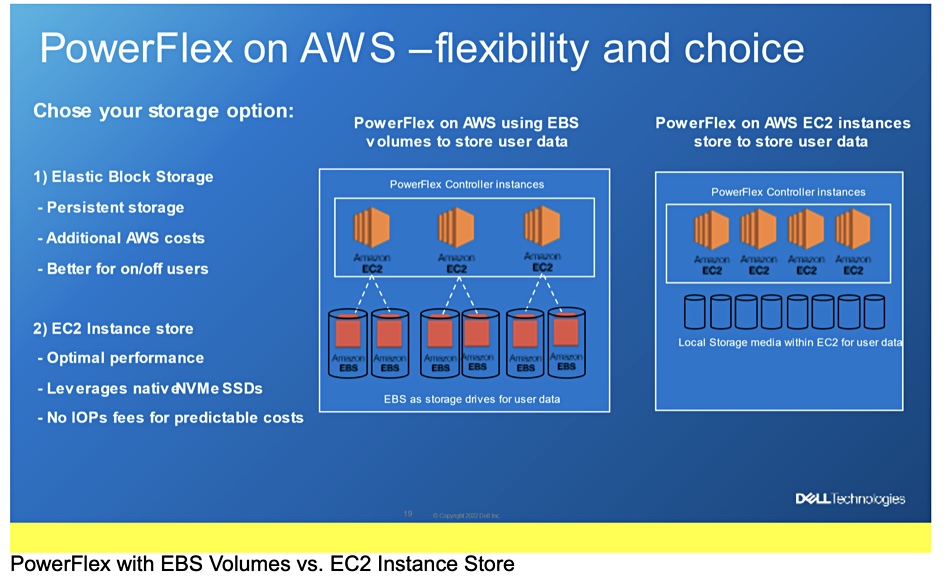Dell has made its PowerFlex hyperconverged infrastructure system available on the AWS marketplace as part of the company’s APEX program to have its storage software operate across private and multiple public clouds.
PowerFlex is Dell’s scale-out virtual SAN and hyperconverged system with multi-hypervisor support, unlike the vSphere-only VxRail. PowerFlex scales out to thousands of nodes and originated as a ScaleIO upgrade and rebrand. Project APEX, revealed in April last year, is a set of managed file and block storage services, including hyperconverged products. Dell says APEX will cover edge, private, and public cloud locations.
A Dell blog by Itzik Reich, VP Technologists for ISG, says: “We’re already working with some very large customers on their implementations with PowerFlex in AWS and look forward to bringing more of our world class storage software to many more public cloud locations – so stay tuned!”
PowerFlex AWS has to use AWS storage services and two are available – Elastic Block Storage (EBS) or the EC2 Instance Store.

EBS volumes are persistent whereas the faster NVMe-based EC2 instance stores are not, even though they use non-volatile drives. This is an AWS oddity as the NVMe SSDs are local to the EC2 instance. If the instance is shut down then, when it restarts, it may well be on other physical AWS servers with different NVMe drives.
PowerFlex AWS applications using EC2 instance stores need to backup their data before closing an instance down. Dell’s DDVE (Data Domain Virtual Edition) could be used for this.
Dell thinks PowerFlex in AWS could be useful for cloud bursting, databases, applications, test/dev, backup, disaster recovery, general consolidation of many workloads onto one platform, data and container mobility, and cloud-based analytics. It is keen to emphasize the linear scalability of PowerFlex AWS with a chart showing straight line growth in IOPS from the base three-node setup to 140 nodes:

This high scalability also means PowerFlex AWS has to have high availability and Dell says it has a unique multi-AZ implementation. This means having a second PowerFlex instance in a different availability zone (AZ) within the same AWS region and the ability to failover should one instance fail.

The PowerFlex AWS deployment wizard enables this, with a single fault set assigned per AZ. For a multiple AZ deployment, fault sets are used to ensure that if there is an AZ failure, there is no PowerFlex data loss.
PowerFlex has a metadata manager (MDM) which configures and monitors the PowerFlex system, looking after migration, rebuilds, and all system-related functions. Three or five MDM instances run on different servers to support high availability. One MDM is given the Master role, and the others act as Slave or Tie-Breaker MDMs. In the PowerFlex AWS service the placement of MDMs has been spread around to minimize the chance of a complete management stack failure.
Dell public cloud migration
Dell says PowerFlex is the first of its storage software offerings to be made available in the public cloud via Project Alpine and compliments its AWS data protection portfolio. Project Alpine is Dell’s initiative to make its file, block, and object storage software available on the main public clouds and so provide data mobility and consistent operations in a hybrid private-public multi-cloud environment.

A Dell slide says PowerStore (unified file and block) and PowerScale (scale-out filer software) will follow PowerFlex. And all three will be available on the AWS, Azure and GCP clouds. In this Dell is following NetApp with its data fabric and ONTAP availability in the cloudy threesome’s offerings. HPE with its GreenLake service has a similar philosophy.
We can expect Dell to announce PowerFlex Azure and GCP in the future, along with PowerStore and PowerScale. This is a massive software porting effort and such full-bore public cloud coverage should help keep Dell’s storage customer base on board as it adopts the hybrid private-public multi-cloud storage service concept.








